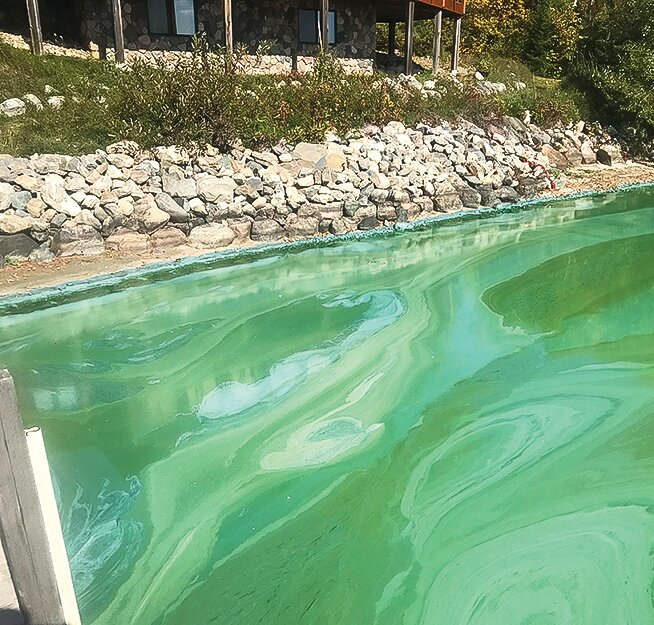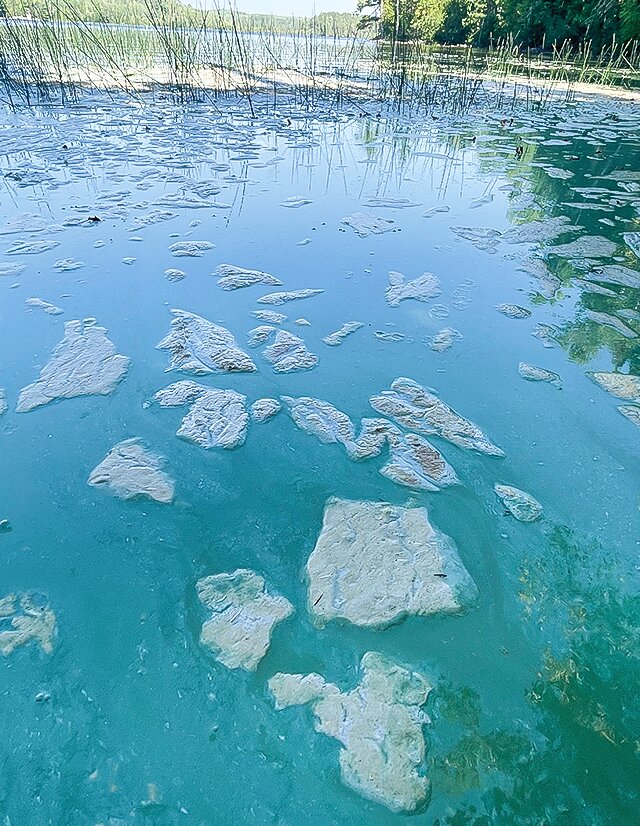Support the Timberjay by making a donation.
Blue, green, and stinky
Vermilion and other area lakes experiencing intense algae blooms
REGIONAL— “The water’s stinky!” That was the assessment of a group of young visitors to Lake Vermilion Soudan Underground Mine State Park last week as a pronounced bloom of …
This item is available in full to subscribers.
Attention subscribers
To continue reading, you will need to either log in to your subscriber account, below, or purchase a new subscription.
Please log in to continue |
Blue, green, and stinky
Vermilion and other area lakes experiencing intense algae blooms
REGIONAL— “The water’s stinky!”
That was the assessment of a group of young visitors to Lake Vermilion Soudan Underground Mine State Park last week as a pronounced bloom of blue-green algae across at least the eastern half of the lake made its sudden appearance obvious to the eyes and the noses of folks hoping to beat the heat with a cooling dip in the water over a record hot Labor Day weekend.
Vermilion isn’t the only lake looking greener than usual right now. Jesse Anderson with the Minnesota Pollution Control Agency said the agency has received reports of algae blooms in lakes across the state. Shagawa Lake, near Ely, is also experiencing an unusually strong bloom of blue-green algae according to reports there.
“Conditions have been worse than average, likely because of the very hot, sunny and dry summer – these are conditions that algae love,” said Anderson.
While some Lake Vermilion residents have been concerned that this year’s bloom reflects a decline in water quality, that’s not necessarily the case, said Anderson.
“Lake Vermilion has lots of water quality data, and it was assessed as meeting our lake water quality standards at the last assessment we did in 2017,” said Anderson. “Our standards include the June – September “summer average” values for total phosphorus, chlorophyll-a (i.e. algae concentration) and water clarity,” he said. “In general algae levels are lower in the Cook end of the Lake compared to the Tower end.”
In fact, the noticeable algae bloom on Vermilion appears to be limited to areas, like the south shore of Pine Island, or bays on the lake’s east end, where persistent southerly or southwesterly winds ahead of the latest heat wave, concentrated algae that blew in from Big Bay.
Blue-green algae is a natural part of virtually every Minnesota lake’s flora, so its presence alone isn’t necessarily cause for concern. “Mild to moderate blooms [of blue-green algae] in Lake Vermilion in late summer and early fall are not uncommon,” said Anderson. “I have seen and documented them in my past work on the lake.”
DNR fisheries staff, who have been conducting their late summer gill netting on Vermilion in recent days, say that the algae— both green and blue-green algae— appears worst on the far east end of the lake, from Cable Bay to Mud Creek Bay, and diminishes to the west. Reports of high blue-green algae populations have also come in to the Timberjay from Canfield Bay, on the south side of Pine Island. Mary Beth Nevers, a seasonal resident on Pine Island, said the bloom is much worse than in past years and she said she’s worried about its impact on fish, loons, people, and dogs.
While lakeshore development can spark additional algae growth on lakes, particularly when lakeshore owners don’t take steps to reduce their use of phosphate-containing detergents and fertilizers, or have leaking septic systems, recent algae blooms haven’t been limited to lakes with large numbers of summer homes and cabins. Last year, some lakes in the Boundary Waters Canoe Area Wilderness, saw extensive algae blooms as well, which suggests other factors may be contributing to the problem.
Research is underway to better understand what might be driving the apparent increase in algae blooms in Minnesota lakes. Scientists suspect that climate change may be playing a role since Minnesota lakes are getting warmer in summer, and that can increase algae growth. Atmospheric deposition of dust or ash from wildfires can also import nutrients, even into remote lakes.
Is blue-green algae toxic?
Blue-green algae, known to scientists as cyanobacteria, can be toxic, although that’s not the case with most species of cyanobacteria. Unfortunately, you can’t tell simply from looking at the algae with the naked eye whether it’s a species capable of creating toxins or not. Which is why it’s best to avoid water with large concentrations of blue-green algae.
According to the MPCA, you can become sick if you swallow, have skin contact with, or breathe in airborne water droplets while swimming, boating, waterskiing, tubing, bathing, or showering in water that has harmful algae or if you drink water that contains algal toxins. If you become sick, you might experience vomiting, diarrhea, rash, eye irritation, cough, sore throat, and headache. Symptoms generally begin hours to two days after exposure.
The activities that put you in contact with the water — and the amount of time you spend on them — will affect your exposure to algae toxins. Children will generally be more affected than adults.
If you rely on untreated lake water for drinking, cooking, showering, or brushing teeth, especially for infants and small children, you should discontinue its use in the presence of blooms of blue-green algae. Boiling water will not destroy algae toxins and could actually increase toxin levels. Simple treatment options are also not effective; multiple treatment steps are typically needed to remove algae toxins.
Water that may be contaminated can still be used for washing dishes, or laundry, though it may irritate skin.
Toxins from algae can accumulate in the entrails (guts) of fish and occasionally in the muscle tissue. Levels in fish depend upon the severity of the bloom in the area where the fish are caught.
In general, fish that are caught in areas of a waterbody where major blue-green algae blooms are occurring may be safe to eat, as long as the guts are discarded. However, it’s uncertain how much algae toxin can accumulate in fillets, so anglers may want to wait a week or two after algae blooms are over before fishing and eating fish from waters where a bloom is occurring.
Pets, especially dogs, are susceptible to harmful algae because they are relatively small and tend to swallow more water while swimming and playing in the water. Dogs may ingest algae if they lick their coats after leaving the water. They are also less deterred by green, smelly water that may contain harmful algae.
To reduce your dog’s exposure to blue-green algae, the MPCA recommends that you don’t let them swim or drink where there is noticeable algae in the water or scum on the shore.
If they did swim in water that could have harmful algae, rinse them off with fresh water immediately. Don’t let them lick their fur.
Animals can experience symptoms within minutes of exposure to the toxins. Symptoms they might experience include vomiting, diarrhea, weakness, difficulty breathing, and seizures. In the worst cases, animals have died. If your pet experiences these symptoms after exposure to algae, contact your veterinarian immediately.









